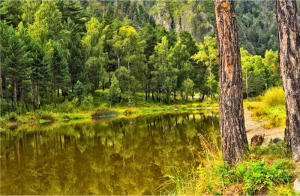Woodman, spare that tree!
                        Touch not a single bough!
                      In youth it sheltered me,
                          And I’ll protect it now.
                                            George Pope Morris
Twelve years ago at this time we had just returned from Costa Rica to celebrate Christmas at home. Close to where we had stayed we watched the beginning of a new building going up, using steel instead of wood.
In this country with vast forests and where all steel is imported, why wouldn’t they use wood? I was told that it was to preserve the trees. When I asked what the building was going to be, I was told… but you need to read to the end of this column to find out!
There is an estimate that humans have cut down or damaged three quarters of the forests that existed before we became the dominant animal on the planet. Costa Rica is no exception; Ticos had cut down large portions of its forests. Fortunately, thanks to that country’s exceptionally good conservation policies and good luck, second growth forests now cover about a seventh of the country’s land area.
We rented a cozy cabin for most of the 3 months that we lived in Monteverde. Perhaps its best quality was its location, bordering the Children’s Eternal Rain Forest. Trees in this area had been cut down for agriculture, and more recently they were allowed to regrow. The land was bought with donations from all over the world. Most impressively, the movement to preserve and rehabilitate this land was started by Swedish elementary school children.
Trees are pretty amazing. In addition to being attractive and fun to climb, they provide shade and purify air and water. They are also part of the carbon cycle, as many kids can tell you. Using sunlight for energy, they suck out carbon dioxide from the air, synthesize cellulose and release oxygen. If that wood burns, the CO2 is returned to the atmosphere. If a tree is allowed to slowly decompose, some of its carbon joins the soil and increases its fertility.
All trees are not created equal, however. In a natural forest there are many different species of trees, plus undergrowth, all filling different ecological niches. On the other hand, a tree monoculture, especially if treated with lots of chemicals, is a poor substitute for a natural forest.
Shade-grown coffee is an example of a good compromise between agricultural production and good ecology. Trees shade the coffee bushes as well as providing homes for many beneficial animals. Hungry birds gobble up harmful insects on the coffee bushes, for example.
Part of the reason we selected Monteverde, Costa Rica as the place to spend a sabbatical was the Quaker connection. Several Quaker families chose to live in the only country in the world that did not have a military force; they founded Monteverde in 1951. They bought a large amount of land very inexpensively, and preserved much of it to insure the purity of their water supply. This uncut, undeveloped cloud forest has become a haven for plants and animals—and for the biologists who study them.
Brazil, in stark contrast to Costa Rica, has been unable to control devastation of its Amazon rainforest. Called the “lungs of the planetâ€, the Amazon is the world’s largest rainforest and is key for the planet’s health. In 2014 the destruction (by harvesting tropical wood and clearing for cattle and other agriculture) has increased by 16%. An area larger than Delaware was cut down in just one year!
Palm oil production is big business in some Asian countries. Often grown in huge plantations, in Indonesia alone the land devoted to palm oil monoculture is almost as large as Connecticut. The native forest is often burned to prepare for the land for planting oil palms, causing terrible air quality. Sadly, this has lead to the destruction of habitat for orangutans and tigers, among other creatures.
What can we do to spare tropical trees? Avoid buying products made with exotic woods. Eat less beef—you’ll be healthier, too! When possible, pass up foods that contain tropical oils such as palm oil.
We visited Monteverde about a year after the sabbatical and found a group of people outside that little building built with steel instead of wood. Most of them were kids, since school had just let out, and they all looked happy—for a good reason. The shop was selling locally made ice cream! Indeed, Monteverde has some of the best ice cream I’ve ever tasted—coffee is my favorite flavor.
© Richard Grossman MD, 2015
